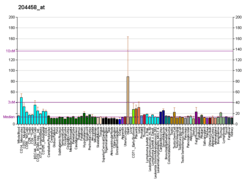LYPLA3
Group XV phospholipase A2 is an enzyme that in humans is encoded by the PLA2G15 gene.[5][6][7]
Lysophospholipases are enzymes that act on biological membranes to regulate the multifunctional lysophospholipids. The protein encoded by this gene hydrolyzes lysophosphatidylcholine to glycerophosphorylcholine and a free fatty acid. This enzyme is present in the plasma and thought to be associated with high-density lipoprotein. A later paper contradicts the function of this gene. It demonstrates that this gene encodes a lysosomal enzyme instead of a lysophospholipase and has both calcium-independent phospholipase A2 and transacylase activities.[7]
References
- 1 2 3 GRCh38: Ensembl release 89: ENSG00000103066 - Ensembl, May 2017
- 1 2 3 GRCm38: Ensembl release 89: ENSMUSG00000031903 - Ensembl, May 2017
- ↑ "Human PubMed Reference:".
- ↑ "Mouse PubMed Reference:".
- ↑ Taniyama Y, Shibata S, Kita S, Horikoshi K, Fuse H, Shirafuji H, Sumino Y, Fujino M (May 1999). "Cloning and expression of a novel lysophospholipase which structurally resembles lecithin cholesterol acyltransferase". Biochem Biophys Res Commun. 257 (1): 50–6. doi:10.1006/bbrc.1999.0411. PMID 10092508.
- ↑ Schaloske RH, Dennis EA (Nov 2006). "The phospholipase A2 superfamily and its group numbering system". Biochim Biophys Acta. 1761 (11): 1246–59. doi:10.1016/j.bbalip.2006.07.011. PMID 16973413.
- 1 2 "Entrez Gene: LYPLA3 lysophospholipase 3 (lysosomal phospholipase A2)".
Further reading
- Wang A, Dennis EA (1999). "Mammalian lysophospholipases". Biochim. Biophys. Acta. 1439 (1): 1–16. doi:10.1016/s1388-1981(99)00063-3. PMID 10395961.
- Maruyama K, Sugano S (1994). "Oligo-capping: a simple method to replace the cap structure of eukaryotic mRNAs with oligoribonucleotides". Gene. 138 (1–2): 171–4. doi:10.1016/0378-1119(94)90802-8. PMID 8125298.
- Suzuki Y, Yoshitomo-Nakagawa K, Maruyama K, et al. (1997). "Construction and characterization of a full length-enriched and a 5'-end-enriched cDNA library". Gene. 200 (1–2): 149–56. doi:10.1016/S0378-1119(97)00411-3. PMID 9373149.
- Ohta T, Michel JJ, Schottelius AJ, Xiong Y (1999). "ROC1, a homolog of APC11, represents a family of cullin partners with an associated ubiquitin ligase activity". Mol. Cell. 3 (4): 535–41. doi:10.1016/S1097-2765(00)80482-7. PMID 10230407.
- Hiraoka M, Abe A, Shayman JA (2002). "Cloning and characterization of a lysosomal phospholipase A2, 1-O-acylceramide synthase". J. Biol. Chem. 277 (12): 10090–9. doi:10.1074/jbc.M111977200. PMID 11790796.
- Strausberg RL, Feingold EA, Grouse LH, et al. (2003). "Generation and initial analysis of more than 15,000 full-length human and mouse cDNA sequences". Proc. Natl. Acad. Sci. U.S.A. 99 (26): 16899–903. doi:10.1073/pnas.242603899. PMC 139241. PMID 12477932.
- Clark HF, Gurney AL, Abaya E, et al. (2003). "The secreted protein discovery initiative (SPDI), a large-scale effort to identify novel human secreted and transmembrane proteins: a bioinformatics assessment". Genome Res. 13 (10): 2265–70. doi:10.1101/gr.1293003. PMC 403697. PMID 12975309.
- Ota T, Suzuki Y, Nishikawa T, et al. (2004). "Complete sequencing and characterization of 21,243 full-length human cDNAs". Nat. Genet. 36 (1): 40–5. doi:10.1038/ng1285. PMID 14702039.
- Abe A, Poucher HK, Hiraoka M, Shayman JA (2004). "Induction of lysosomal phospholipase A2 through the retinoid X receptor in THP-1 cells". J. Lipid Res. 45 (4): 667–73. doi:10.1194/jlr.M300342-JLR200. PMID 14754907.
- Zhang Z, Henzel WJ (2005). "Signal peptide prediction based on analysis of experimentally verified cleavage sites". Protein Sci. 13 (10): 2819–24. doi:10.1110/ps.04682504. PMC 2286551. PMID 15340161.
- Gerhard DS, Wagner L, Feingold EA, et al. (2004). "The status, quality, and expansion of the NIH full-length cDNA project: the Mammalian Gene Collection (MGC)". Genome Res. 14 (10B): 2121–7. doi:10.1101/gr.2596504. PMC 528928. PMID 15489334.
- Otsuki T, Ota T, Nishikawa T, et al. (2007). "Signal sequence and keyword trap in silico for selection of full-length human cDNAs encoding secretion or membrane proteins from oligo-capped cDNA libraries". DNA Res. 12 (2): 117–26. doi:10.1093/dnares/12.2.117. PMID 16303743.
This article is issued from
Wikipedia.
The text is licensed under Creative Commons - Attribution - Sharealike.
Additional terms may apply for the media files.




